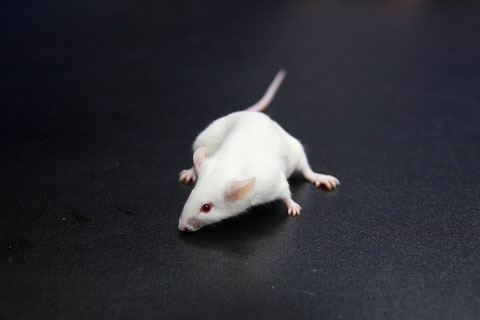Mouse Baby: 'I Have Two Daddies!'

In a first for stem-cell technology, researchers have produced mice with two fathers.
The mice, developed at M.D. Anderson Cancer Center in Houston, contain no maternal DNA. Instead, their genomes are made up of contributions from two male mice. The technology could eventually be used to breed prize livestock or endangered species in which few or no females remain, according to the researchers. Any practical application in humans is a long way off.
Related cell-engineering methods have produced monkeys from two mothers. Researchers from the U.K. have created human embryos with DNA from three parents, though those embryos were sustained only in a lab and never meant for reproduction.
Producing the motherless mice took some fancy lab work. First, researchers engineered cells from a male mouse fetus — Father No. 1 — to turn the cells into pluripotent stem cells. Pluripotent stem cells can become any cell in the body.
Male cells normally have one X and one Y chromosome, while females have two X chromosomes. However, when researchers make pluripotent stem cells in the lab, about 1 percent spontaneously lose their Y chromosomes because of natural genetic mistakes. Those stem cells are left with just an X chromosome.
The researchers took these X-only (or "XO") cells and injected them into normal mouse embryos, which they then implanted in a surrogate mother mouse. The resulting baby mice were chimeras, or organisms with several distinct populations of cells. About half of the mice were female chimeras with some XX cells (which came from the normal embryo) and some XO cells, which contained DNA from Father No. 1.
When the female chimeras reached adulthood, the researchers mated them with regular male mice. Some of the females' egg cells derived from the XO cells. Those cells contained DNA from Father No. 1 only, so when the female chimeras mated with another male — Father No. 2 — some of the offspring thus had an X chromosome from Father No. 1 and either an X or Y chromosome from Father No. 2.
Sign up for the Live Science daily newsletter now
Get the world’s most fascinating discoveries delivered straight to your inbox.
So far, three males, two XX females and five XO females with only daddy-DNA have been born, the researchers reported Nov. 8 in the journal Biology of Reproduction.
The researchers write that the techniques could be modified so that "some day two men could produce their own genetic sons and daughters." To do so without the multigenerational approach used to produce the mice, scientists would have to coax male cell lines to generate egg cells.
But the technical and ethical barriers to transferring the process to humans are extremely high, both because cell reprogramming can trigger tumors and because humans who inherit only one X chromosome rarely survive. Women born with only one X chromosome are infertile and often face health problems such as congenital heart disease and thyroid disorder.
You can follow LiveScience Senior Writer Stephanie Pappas on Twitter @sipappas.

Stephanie Pappas is a contributing writer for Live Science, covering topics ranging from geoscience to archaeology to the human brain and behavior. She was previously a senior writer for Live Science but is now a freelancer based in Denver, Colorado, and regularly contributes to Scientific American and The Monitor, the monthly magazine of the American Psychological Association. Stephanie received a bachelor's degree in psychology from the University of South Carolina and a graduate certificate in science communication from the University of California, Santa Cruz.










